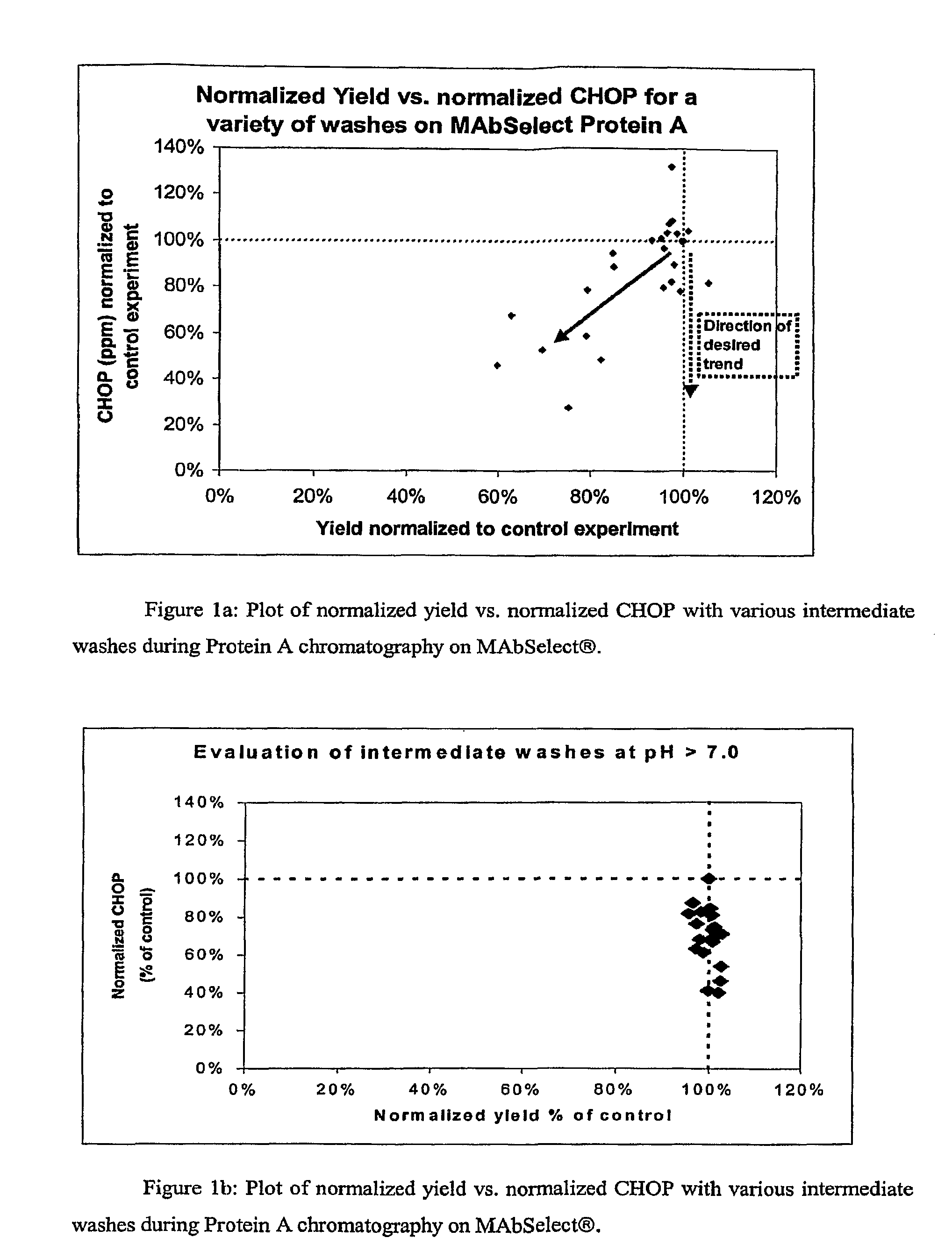Method for purifying a protein using protein-A affinity chromatography using an intermediate wash step
a technology of affinity chromatography and purification method, which is applied in the field of protein purification, can solve the problems of increasing the possibility of product loss and reducing the purity of the final protein produ
- Summary
- Abstract
- Description
- Claims
- Application Information
AI Technical Summary
Benefits of technology
Problems solved by technology
Method used
Image
Examples
example 1
[0063]This experiment provides details regarding the chromatographic behavior of Chinese Hamster Ovary Protein contaminants (CHOP) present in CHO cell culture harvest supernatant with and without a spiked antibody product to determine if CHOP interacts with the Protein A backbone material or if it directly interacts with protein product bound to the Protein A. CHO cell culture harvest supernatant was prepared from untransfected CHO cells (the null supernatant). The “spiked” supernatant was prepared by adding purified monoclonal antibody to the OX40 ligand (Khare et al., WIPO International Publication No. WO 05 / 094879) at a concentration of ˜1 mg / ml to the null supernatant, incubated overnight. The null and spiked supernatants were then loaded onto Protein A immobilized on two different types of supports: an agarose-base support (MAbSelect™, Amersham Biosciences, Uppsala, Sweden) and a pore glass matrix (Prosep A®, Millipore, Billerica, Mass.). The columns were then subjected to a wa...
example 2
[0065]Protocols for protein purification using MAbSelect™ Protein A columns typically require the intermediate wash to have a pH somewhere between that of the equilibration buffer and of the elution buffer. The buffer formulation and pH are independently determined for each protein to be purified. A generic intermediate wash buffer that could be used effectively during purification of a wide range of proteins would eliminate this need. Also, described in Example 1, CHOP was found to associate with the protein of interest when purified on agarose-based Protein A resins, compared to glass resins where more CHOP was associated with the resin backbone. There is a need for buffers that can reduce the association of contaminants and the protein of interest. Accordingly, a series of experiments were carried out to compare the effectiveness of various wash buffer formulations. MAbSelect™ Protein A columns were prepared according to manufacturer's directions. The columns were loaded with CHO...
example 3
[0074]The above experiments were carried out using material from a single lot of cell culture harvest fluid expressing an OX40L monoclonal antibody. To test the generality of the observations made in the above, four different cell culture harvest lots of the OX40L monoclonal antibody were loaded onto MAbSelect™ Protein A columns as described above. The intermediate wash buffer formulation: 25 mM Tris, 10% isopropanol, 1M urea, pH 9.0, was used. For each lot a control experiment was carried out involving an extended wash with equilibration buffer (25 mM Tris, 100 mM NaCl, pH 7.4) followed by a pre-elution wash (3CV of 50 mM citrate, pH 4.4) and compared to the wash combination of equilibration buffer (3CV of 25 mM Tris, 100 mM NaCl, pH 7.4), an intermediate wash (25 mM Tris, 10% isopropanol, 1M urea, pH 9.0), followed by pre-elution buffer (3 CV of 50 mM citrate, pH 4.4) and elution of the antibody, The normalized CHOP and yield data are shown in Table 3. As can be seen in Table 3, t...
PUM
| Property | Measurement | Unit |
|---|---|---|
| pH | aaaaa | aaaaa |
| pH | aaaaa | aaaaa |
| pH | aaaaa | aaaaa |
Abstract
Description
Claims
Application Information
 Login to View More
Login to View More - R&D
- Intellectual Property
- Life Sciences
- Materials
- Tech Scout
- Unparalleled Data Quality
- Higher Quality Content
- 60% Fewer Hallucinations
Browse by: Latest US Patents, China's latest patents, Technical Efficacy Thesaurus, Application Domain, Technology Topic, Popular Technical Reports.
© 2025 PatSnap. All rights reserved.Legal|Privacy policy|Modern Slavery Act Transparency Statement|Sitemap|About US| Contact US: help@patsnap.com

